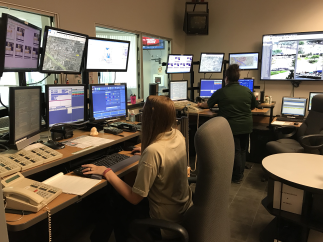
The Operations Unit is on the job 24 hours a day, 365 days a year. The unit is commanded by Assistant Chief Christopher Deaton and is the largest unit within the Police Department.
Operations provides law enforcement services to the main campus, UNT Discovery Park, as well as the surrounding area. These services include, but are not limited to, responding to calls for service, apprehending criminal suspects, writing reports, traffic enforcement, and conducting preliminary investigations. Also falling under Operations is Communications (Police Dispatch) and Community Relations.
Officers patrol in both marked and unmarked vehicles, on bicycle, and on foot. Our vehicles are equipped with state of the art equipment to include multi-channel scanning radios, mobile data terminals, radar and laser speed detection, digital mobile video, and forward looking infrared cameras.
The University of North Texas Police Department
Communications

The Sullivant Public Safety Center houses a fully functional telecommunications center, staffed by state certified Telecommunications Officers. As an integral part of the police department, dispatchers provide communications support for police, fire, emergency, and other related services. The nature of the position puts dispatchers on the front line of an emergency situation and in the forefront of service delivery. Some of the services provided by Dispatch include:
- Available to the University community by telephone, TDD, and walk-in 24 hours a day, 7 days a week, 365 days a year
- Receive emergency and non-emergency phone calls
- Radio dispatch officers and monitor their activity
- Monitor fire and burglar alarm systems for the entire campus
- Provide real-time updates to incidents via the departments' Computer Aided Dispatch (CAD) / Records Management System (RMS)
- Access local, state and federal data via the Texas Crime Information Center (TCIC) and the National Crime Information Center (NCIC)
Texting to 911 Tips
Citizens who find themselves in an emergency situation and unable to make a voice call to 9-1-1 should remember these steps:
- Don't text and drive
- In the first text message send the location and type of emergency.
- Text in simple words - Send a short text message without abbreviations or slang.
- Be prepared to answer questions and follow instructions from the 9-1-1 call taker.
- Photos and videos cannot be sent to 911 at this time.
- Text-to-911 cannot include more than one person.
- Do not send your emergency text to anyone other than 9-1-1.
- Voice calls to 9-1-1 are always the best and fastest way get help
Text-to-911 service is not available everywhere and is subject to the same limitations and challenges as all wireless calls. If you do not receive a text response from 9-1-1, try to contact 9-1-1 via phone.
Communications falls under Operations which is supervised by Assistant Chief Chris Deaton.
The University of North Texas Police Department